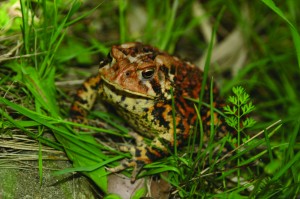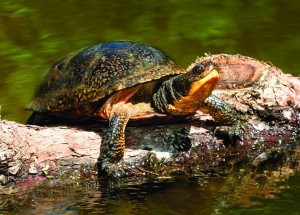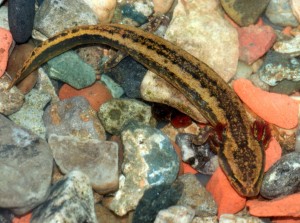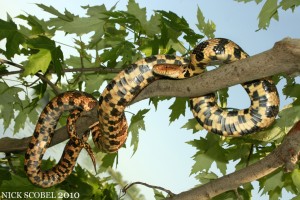Text by David Mifsud, Herpetological Resource and Management, LLC
Photos by Herpetological Resource and Management, LLC, unless noted otherwise
April, 2014
Reptiles and Amphibians – collectively, herpetofauna – are ecologically important groups that fill a critical mid-level position in food webs; serving as predators, scavengers, and important prey for higher predators. Occupying such a unique position, herpetofauna are key bioindicators of ecosystem health and habitat quality as they are typically sensitive to disruption in the environment. In recent decades herpetofauna populations have declined throughout the Great Lakes region due largely to habitat loss, degradation and fragmentation. In Michigan, more than 60% of all species of amphibian and reptile are considered Species of Greatest Conservation Need by the Michigan Department of Natural Resources. As such, there is a need to target this group for conservation while working to restore sensitive Great Lakes aquatic habitats.
Habitat for herpetofauna and other wildlife within the Great Lakes region is degrading rapidly due to a variety of factors including the highly invasive plant Phragmites australis, also known as the common reed, which grows in dense monoculture stands and dominates local plant communities. It is known that Phragmites fragments natural reptile and amphibian habitats by creating physical barriers to movement across the landscape and crowding out and shading necessary habitat components, such as nesting and basking areas. Herpetofauna depend on maintaining ideal body temperatures through thermoregulation which is impacted by dense growing Phragmites as the thick stands prevent movement to and from open water sources and optimal areas of sun and shade.
Understanding the effects that invasive Phragmites and other forms of habitat degradation have on local wildlife populations can help contribute to the long-term conservation of amphibian and reptile species in Michigan as well as other Great Lakes states. The Michigan Department of Environmental Quality (MDEQ) Coastal Zone Management Program recently funded a three year study surveying herpetofauna populations throughout the Saginaw Bay area. Between 2011 and 2013, comprehensive surveys conducted by Herpetological Resource and Management (HRM), revealed the negative effects that habitat degradation associated with Phragmites is having on local amphibian and reptile populations and the overall quality of coastal habitats within the region. This novel work, which has been published in the Journal of Great Lakes Research demonstrates a need for the restoration of Great Lakes coastal habitat including a focus on the eradication of Phragmites.
Conservation efforts that focus on controlling Phragmities will help restore habitat for herpetofauna while also improving the overall quality of Great Lakes coastal habitats throughout Michigan. There are many things to consider when managing for this aggressively persistent plant invader including what methods will be most effective. A useful tool in helping evaluate the potential risks of management or action to eradicate Phragmites from coastal habitats can be found within the recently published Michigan Amphibian and Reptile Best Management Practices Manual. This unique document provides an introduction to the herpetofauna of Michigan including habitat needs and how to best manage the landscape to preserve these sensitive animals. The BMP also provides simple and cost effective ways to create and restore amphibian and reptile habitat. Restoring Great Lakes habitat is critical for the long-term viability of amphibians and reptiles in Michigan and will aid in recolonization of rare or extirpated species while also keeping common species common. Ways you can help locally include contributing to the MI Herp Atlas Project. This is the only comprehensive database for all Michigan Amphibians and reptiles and a critical resource in helping to protect and best manage for these sensitive and declining species. The online database and mobile phone app makes contributing data fast and easy. Outside of Michigan, you can use the Global Herp Mapper.




